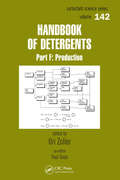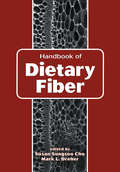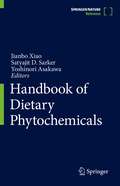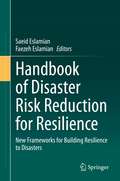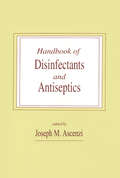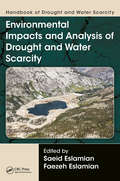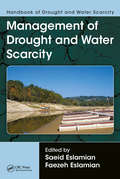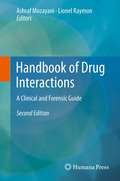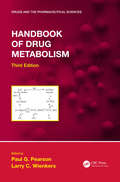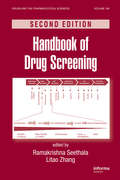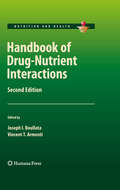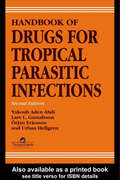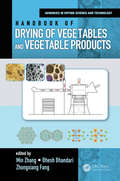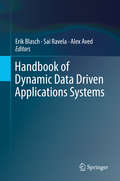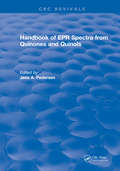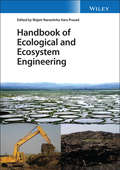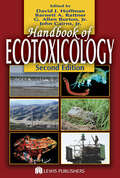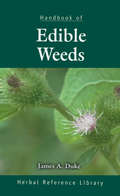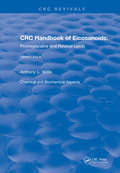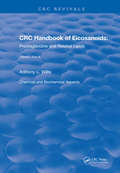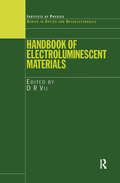- Table View
- List View
Handbook of Detergents, Part F: Production (Surfactant Science)
by Uri ZollerThis sixth part of the multi-volume Handbook of Detergents focuses on the production of surfactants, builders and other key components of detergent formulations, including the various multi-dimensional aspects and implications on detergent formulations and applications domestically, institutionally, in industry and agriculture, with all the environ
Handbook of Dietary Fiber: An Applied Approach (Food Science And Technology Ser. #Vol. 25)
by Susan Sungsoo Cho; Mark L. DreherPresents the latest research on the analysis, metabolism, function, and physicochemical properties of fiber, fiber concentrates, and bioactive isolates--exploring the effect of fiber on chronic disease, cardiovascular health, cancer, and diabetes. Examines food applications and the efficacy and safety of psyllium, sugar beet fiber, pectin, alginate, gum arabic, and rice bran.
Handbook of Dietary Phytochemicals
by Satyajit D. Sarker Yoshinori Asakawa Jianbo XiaoThis book summarizes recent advances in the chemistry, bioactivity, nutrition, and functional aspects of dietary phytochemicals, as well as the health and functional aspects of foods rich in phytochemicals. Consisting of forty-four chapters, it discusses the different chemical types of phytochemicals in our diets and food and presents data collected from animal or human experiments that are directly related to human health. Each chapter covers the chemistry, epidemiological study, bioavailability, bioactivity (animal experiments) function in humans and safety, as well as products on the market. Moreover, the more than 200 figures make it easy to grasp the main findings in each area.
Handbook of Disaster Risk Reduction for Resilience: New Frameworks for Building Resilience to Disasters
by Saeid Eslamian Faezeh EslamianThis book is part of a six-volume series on Disaster Risk Reduction and Resilience. The series aims to fill in gaps in theory and practice in the Sendai Framework, and provides additional resources, methodologies and communication strategies to enhance the plan for action and targets proposed by the Sendai Framework. The series will appeal to a broad range of researchers, academics, students, policy makers and practitioners in engineering, environmental science and geography, geoscience, emergency management, finance, community adaptation, atmospheric science and information technology. This volume discusses how to measure and build disaster resilience at society’s capacity, drawing upon individual, institutional and collective resources to cope with and adapt to the demands and challenges of natural disaster occurrences. The book will serve as a guide, outlining the key indicators of disaster resilience in urban and rural settings, and the resources and strategies needed to build resilient communities in accordance with the targets of the Sendai Framework. Readers will learn about multi-risk reduction approaches using computational methods, data mining techniques, and System Thinking at various scales, as well as institutional and infrastructure resilience strategies based on several case studies.
Handbook of Disinfectants and Antiseptics
by Joseph M. AscenziThis work details current medical uses of antiseptics and disinfectants, particularly in the control of hospital-acquired infections. It presents methods for evaluating products to obtain regulatory approval, and examines chemical, physical and microbiological properties as well as the toxicology of the most widely-used commercial chemicals. Formul
Handbook of Drought and Water Scarcity: Environmental Impacts and Analysis of Drought and Water Scarcity
by Saeid Eslamian Faezeh A. EslamianThis volume includes over 30 chapters, written by experts from around the world. It examines the environmental aspects of drought such as groundwater and soil contamination, river low-flow, urban water quality, and desertification. It also examines the effects of climate change and variability on drought, and discusses the differences in groundwater, rainfall, and temperatures and their related effects. It presents analytical modeling for better understanding drought in uncertain and changing climates.
Handbook of Drought and Water Scarcity: Management of Drought and Water Scarcity
by Saeid Eslamian Faezeh A. EslamianThis volume includes over 30 chapters, written by experts from around the world. It examines numerous management strategies for dealing with drought and scarcity. These strategies include management approaches for different regions, such as coastal, urban, rural, and agricultural areas. It offers multiple strategies for monitoring, assessing, and forcasting drought through the use of remote sensing and GIS tools. It also presents drought mitigation management strategies, such as groundwater management, rainwater harvesting, conservations practices, and more.
Handbook of Drought and Water Scarcity: Principles of Drought and Water Scarcity
by Saeid Eslamian Faezeh A. EslamianThis volume include over 30 chapters, written by experts from around the world. It examines drought and all of the fundamental principles relating to drought and water scarcity. It includes coverage of the causes of drought, occurences, preparations, drought vulnerability assessments, societal implications, and more.
Handbook of Drug Interactions
by Ashraf Mozayani Lionel RaymonAdverse drug reactions and interactions are still a major headache for healthcare professionals around the world. The US Food and Drug Administration's database recorded almost 300,000 serious adverse events in 2009 alone, of which 45,000 instances proved fatal. This updated new edition of the indispensable guide to drug interactions incorporates fresh research completed since the book's original publication by Humana Press in 2004. Additions include a new section on pharmacogenomics, a rapidly growing field that explores the genetic basis for the variability of responses to drugs. This new material reviews important polymorphisms in drug metabolizing enzymes and applies the findings to forensic interpretation, using case studies involving opiates as exemplars. Existing chapters from the first edition have in most cases been updated and reworked to reflect new data or incorporate better tables and diagrams, as well as to include recent drugs and formulations. Recent references have been inserted too. The handbook features extra material on illicit drug use, with a new chapter tackling the subject that covers cocaine, amphetamines and cannabis, among others. The section on the central nervous system also deals with a number of drugs that are abused illicitly, such as benzodiazepines, opiates flunitrazepam and GHB, while so-called 'social' drugs such as alcohol and nicotine are still discussed in the book's section on environmental and social pharmacology. Focusing as before on detailed explanation and incorporating both pharmacokinetic and pharmacodynamic drug interactions, this book will continue to be a lodestar for health and forensic professionals as well as students.
Handbook of Drug Metabolism, Third Edition (ISSN #Vol. 186)
by Paul G. Pearson and Larry C. WienkersThis book continues to be the definitive reference on drug metabolism with an emphasis on new scientific and regulatory developments. It has been updated based on developments that have occurred in the last 5 years, with new chapters on large molecules disposition, stereo-selectivity in drug metabolism, drug transporters and metabolic activation of drugs. Some chapters have been prepared by new authors who have emerged as subject area experts in the decade that has passed since publication of the first edition.
Handbook of Drug Screening (Drugs and the Pharmaceutical Sciences)
by Litao Zhang Ramakrishna SeethalaBuilding upon the foundation of basics discussed in the previous edition, the Second Edition provides a more in-depth look at the latest methods and technologies of advanced drug screening, an essential function of drug discovery. With extensively updated content and 21 new chapters, this text examines:quality and efficiency of drug target validati
Handbook of Drug-Nutrient Interactions
by Vincent T. Armenti Joseph I. BoullataHandbook of Drug-Nutrient Interactions, Second Edition is an essential new work that provides a scientific look behind many drug-nutrient interactions, examines their relevance, offers recommendations, and suggests research questions to be explored. In the five years since publication of the first edition of the Handbook of Drug-Nutrient Interactions new perspectives have emerged and new data have been generated on the subject matter. Providing both the scientific basis and clinical relevance with appropriate recommendations for many interactions, the topic of drug-nutrient interactions is significant for clinicians and researchers alike. For clinicians in particular, the book offers a guide for understanding, identifying or predicting, and ultimately preventing or managing drug-nutrient interactions to optimize patient care. Divided into six sections all chapters have been revised or are new to this edition. Chapters balance the most technical information with practical discussions and include outlines that reflect the content; discussion questions that can guide the reader to the critical areas covered in each chapter, complete definitions of terms with the abbreviation fully defined and consistent use of terms between chapters. The editors have performed an outstanding service to clinical pharmacology and pharmaco-nutrition by bringing together a multi-disciplinary group of authors. Handbook of Drug-Nutrient Interactions, Second Edition is a comprehensive up-to-date text for the total management of patients on drug and/or nutrition therapy but also an insight into the recent developments in drug-nutrition interactions which will act as a reliable reference for clinicians and students for many years to come.
Handbook of Drugs for Tropical Parasitic Infections
by Urban Hellgren Orjan Ericsson Lars L GustafssonParasitic infections such as malaria, schistosomiasis, trypanosomiasis and onchoceriasis are the scourge of the tropical countries. Many of the drugs used for the treatment of tropical parasitic infections were introduced more than 30 years ago. Most of these drugs are toxic and have complicated dosage regimens, but, because of the low economic inc
Handbook of Drying of Vegetables and Vegetable Products (Advances in Drying Science and Technology)
by Bhesh Bhandari Min Zhang Zhongxiang FangThis handbook provides a comprehensive overview of the processes and technologies in drying of vegetables and vegetable products. The Handbook of Drying of Vegetables and Vegetable Products discusses various technologies such as hot airflow drying, freeze drying, solar drying, microwave drying, radio frequency drying, infrared radiation drying, ultrasound assisted drying, and smart drying. The book’s chapters are clustered around major themes including drying processes and technologies, drying of specific vegetable products, properties during vegetable drying, and modeling, measurements, packaging & safety. Specifically, the book covers drying of different parts and types of vegetables such as mushrooms and herbs; changes to the properties of pigments, nutrients, and texture during drying process; dried products storage; nondestructive measurement and monitoring of moisture and morphological changes during vegetable drying; novel packaging; and computational fluid dynamics.
Handbook of Dynamic Data Driven Applications Systems
by Sai Ravela Erik Blasch Alex AvedThe Handbook of Dynamic Data Driven Applications Systems establishes an authoritative reference of DDDAS, pioneered by Dr. Darema and the co-authors for researchers and practitioners developing DDDAS technologies.Beginning with general concepts and history of the paradigm, the text provides 32 chapters by leading experts in10 application areas to enable an accurate understanding, analysis, and control of complex systems; be they natural, engineered, or societal:Earth and Space Data AssimilationAircraft Systems ProcessingStructures Health MonitoringBiological Data AssessmentObject and Activity TrackingEmbedded Control and CoordinationEnergy-Aware OptimizationImage and Video ComputingSecurity and Policy CodingSystems Design The authors explain how DDDAS unifies the computational and instrumentation aspects of an application system, extends the notion of Smart Computing to span from the high-end to the real-time data acquisition and control, and manages Big Data exploitation with high-dimensional model coordination.
Handbook of EPR Spectra from Quinones and Quinols
by Jens A. PedersenThis handbook contains a complication of Electron Paramagnetic Resonance (EPR) data of numerous semiquinones and related radicals. The handbook is intended as a general reference guide to the structural studies of the radicals obtained by redox processes from natural and synthetic quinones and quinols.
Handbook of Ecological Models used in Ecosystem and Environmental Management (Applied Ecology and Environmental Management)
by Sven Erik JørgensenIt is estimated that roughly 1000 new ecological and environmental models join the ranks of the scientific literature each year. The international peer-reviewed literature reports some 20,000 new models spanning the period from 1970-2010. Just to keep abreast of the field it is necessary to design a handbook of models that doesn't merely list them,
Handbook of Ecological and Ecosystem Engineering
by Majeti Narasimha Vara PrasadLearn from this integrated approach to the management and restoration of ecosystems edited by an international leader in the field The Handbook of Ecological and Ecosystem Engineering delivers a comprehensive overview of the latest research and practical developments in the rapidly evolving fields of ecological and ecosystem engineering. Beginning with an introduction to the theory and practice of ecological engineering and ecosystem services, the book addresses a wide variety of issues central to the restoration and remediation of ecological environments. The book contains fulsome analyses of the restoration, rehabilitation, conservation, sustainability, reconstruction, remediation, and reclamation of ecosystems using ecological engineering techniques. Case studies are used to highlight practical applications of the theory discussed within. The material in the Handbook of Ecological and Ecosystem Engineering is particularly relevant at a time when the human population is dramatically rising, and the exploitation of natural resources is putting increasing pressure on planetary ecosystems. The book demonstrates how modern scientific ecology can contribute to the greening of the environment through the inclusion of concrete examples of successful applied management. The book also includes: A thorough discussion of ecological engineering and ecosystem services theory and practice An exploration of ecological and ecosystem engineering economic and environmental revitalization An examination of the role of soil meso and macrofauna indicators for restoration assessment success in a rehabilitated mine site A treatment of the mitigation of urban environmental issues by applying ecological and ecosystem engineering A discussion of soil fertility restoration theory and practice Perfect for academic researchers, industry scientists, and environmental engineers working in the fields of ecological engineering, environmental science, and biotechnology, the Handbook of Ecological and Ecosystem Engineering also belongs on the bookshelves of environmental regulators and consultants, policy makers, and employees of non-governmental organizations working on sustainable development.
Handbook of Ecosystem Theories and Management
by F. Müller S. E. JørgensenAs part of the Environmental and Ecological Modeling Handbooks series, the Handbook of Ecosystem Theories and Management provides a comprehensive overview of ecosystem theory and the tools - ecological engineering, ecological modeling, ecotoxicology and ecological economics -to manage these systems. The book is laid out to provide a summary or
Handbook of Ecotoxicology
by John Cairns Barnett A. Rattner David J. Hoffman G. Allen BurtonCompletely revised and updated with 18 new chapters, this second edition includes contributions from over 75 international experts. Also, a Technical Review Board reviewed all manuscripts for accuracy and currency. Focusing on toxic substance and how they affect the ecosystems worldwide, the book presents methods for quantifying and measuring ecotoxicological effects in the field and in the lab, as well as methods for estimating, predicting, and modeling in ecotoxicology studies. This is the definitive reference for students, researchers, consultants, and other professionals in the environmental sciences, toxicology, chemistry, biology, and ecology - in academia, industry, and government.
Handbook of Edible Weeds: Herbal Reference Library
by James A. Duke"If you can't beat it, eat it." Words of wisdom from the author of this portable guide that emphasizes finding practical uses for weeds rather than waging pesticidal war on them. CRC Handbook of Edible Weeds contains detailed descriptions and illustrations of 100 edible weeds, representing 100 genera of higher plant species. Some of the species are strictly American, but many are cosmopolitan weeds. Each account includes common names recognized by the Weed Science Society of America, standard Latin scientific names, uses, and distribution (geographic and ecological). Cautionary notes are included regarding the potential allergenic or other harmful properties of many of the weeds. CRC Handbook of Edible Weeds is an excellent volume for botanists, plant scientists, horticulturalists, herbalists, and others interested in the edibility and practical uses of weeds.
Handbook of Edible Weeds: Herbal Reference Library
by James A. DukeHandbook of Edible Weeds contains detailed descriptions and illustrations of 100 edible weeds, representing 100 genera of higher plant species. Some of the species are strictly American, but many are cosmopolitan weeds. Each account includes common names recognized by the Weed Science Society of America, standard Latin scientific names, uses, and distribution (geographic and ecological). Cautionary notes are included regarding the potential allergenic or other harmful properties of many of the weeds.
Handbook of Eicosanoids: Volume I, Part A (CRC Press Revivals)
by A. L. WillisBuilding upon the extensive compilation of biochemical data featured in Volume I of the Handbook of Eicosanoids, the new Volume II describes the past, present, and potential future impact of eicosanoid research on new drug development. The reader is taken from a historical perspective through state-of-the-art basic concepts to extensive tabulation of molecular structures of compounds known to act via the eicosanoid system. Much emphasis is given to recent breakthroughs in the mechanism of action of anti-inflammatory corticosteroids and the development of receptor antagonists for prostaglandins and leukotrienes. There is also an introductory chapter that proposes areas that require further investigation and novel approaches using existing technology. This handbook will thus be invaluable for medicinal chemists, pharmacologists, and all those involved in basic research in the eicosanoid area. In addition, many parts of this handbook are suitable for use by university lecturers and students. There are 20 figures and 44 extensive tables as well as a bibliography containing more than 2,000 references that complement the text.
Handbook of Eicosanoids: Volume I, Part B (CRC Press Revivals)
by A. L. WillisBuilding upon the extensive compilation of biochemical data featured in Volume I of the Handbook of Eicosanoids, the new Volume II describes the past, present, and potential future impact of eicosanoid research on new drug development. The reader is taken from a historical perspective through state-of-the-art basic concepts to extensive tabulation of molecular structures of compounds known to act via the eicosanoid system. Much emphasis is given to recent breakthroughs in the mechanism of action of anti-inflammatory corticosteroids and the development of receptor antagonists for prostaglandins and leukotrienes. There is also an introductory chapter that proposes areas that require further investigation and novel approaches using existing technology. This handbook will thus be invaluable for medicinal chemists, pharmacologists, and all those involved in basic research in the eicosanoid area. In addition, many parts of this handbook are suitable for use by university lecturers and students. There are 20 figures and 44 extensive tables as well as a bibliography containing more than 2,000 references that complement the text.
Handbook of Electroluminescent Materials (Series in Optics and Optoelectronics)
by D. R. VijAn electroluminescent (EL) material is one that emits electromagnetic (EM) radiation in the visible or near visible range when an electric field is applied to it. EL materials have a vast array of applications in the illumination and displays industries, from cheap and energy efficient lighting to large high resolution flat panel displays.
